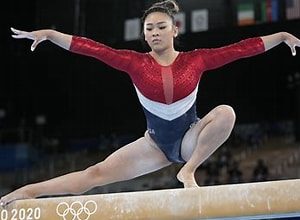A Victory for the Unseen
Sunisa Lee’s gold medal at the Olympics in the all-round gymnastics competition is a victory for the unseen, and a victory the Hmong people in America.
As I watched, I felt a small share in their joy. In 1978 our small congregation in Carnation, Washington, Tolt Congregational Church (UCC), sponsored a refugee family from southeast Asia. The family who came to us were Hmong, the Cha family. Chua Pa and Va and their four children. Two more children were born to the Cha family once in the U.S., one of them they named “Tony.”
 Sunisa Lee’s gold medal was won for the Hmong people, and for her community in Minnesota, perhaps the largest community of Hmong in the U.S. In hailing her victory they have described themselves, and been described, as a hitherto “unseen” people. I’m sure that’s true. I imagine that many in America, even now, have never heard of the Hmong and have no idea of their story.
Sunisa Lee’s gold medal was won for the Hmong people, and for her community in Minnesota, perhaps the largest community of Hmong in the U.S. In hailing her victory they have described themselves, and been described, as a hitherto “unseen” people. I’m sure that’s true. I imagine that many in America, even now, have never heard of the Hmong and have no idea of their story.
That continues a pattern. The Hmong fought, on the side of the U.S. in our “Secret War” in Laos during the Vietnam War. They were recruited by the CIA. Chua Pa was a commander of Hmong soldiers in that “secret war,” a war in which as many as 200,000 Hmong may have died. After the war in Vietnam ended, the Hmong were in the position of Afghans today who have supported the U.S. troops in their country. That is to say, they were in big trouble. Many fled across the Mekong River — no small river and no small task — to Thailand and to refugee camps there. The Cha’s were among them.
When the Cha family came to the small logging and farming town of Carnation (population 700) they were the only non-Caucasian people there. We worried about how they would be received. While I am sure there were unpleasant incidents over the years, by and large the community was receptive and supportive. A man with a landscaping business stepped forward to hire Chua Pa. Members of the congregation helped the Cha’s make a home in the church’s parsonage and built bridges into the community and to the schools, where the Hmong children were welcomed.
Other Hmong followed the Cha’s to Carnation. Within a couple years, there was community of between 60 and 70 Hmong — nearly 10% of the town’s population there. I can still see family groups walking in single file down the streets of Carnation dressed in the traditional, finely embroidered, garments of the Hmong. If it was a strange sight for this small town in the foothills of the Cascades, it must have been far stranger for the Hmong themselves. They had come from what was essentially a pre-modern tribal culture in the remote mountains of Laos and Vietnam.
I’m sure it wasn’t easy, but they made a success of it, in really a very short time. They started growing flowers and vegetables in the fertile Snoqualmie River Valley flatlands, eventually having thriving businesses in both Pike Place Market and Bellevue. Some of the Hmong kids made a name for themselves in high school sports. Most went on to community college and universities. They bought homes in a new subdivision and before long were driving their own cars and pick-ups. All the while . . . largely unseen, unknown as a people.
So when Sunisa Lee’s community exploded in joy as she won the gold medal (scroll down in article to see video), it was an incredible and moving moment for all of the Hmong — and for those of us who fortunate enough to know them — as they proudly claimed a place in America which they more than deserve.
![Anthony B. Robinson [logo]](https://www.anthonybrobinson.com/wp-content/themes/anthonybrobinson/images/logo.png)
![Anthony B. Robinson [logo]](https://www.anthonybrobinson.com/wp-content/themes/anthonybrobinson/images/logo-print.png)